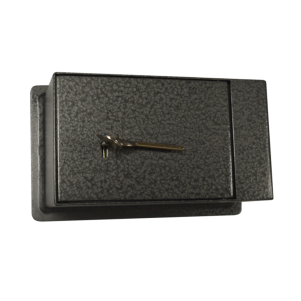How secure are wall safes? pros and cons
Safes come in all shapes and sizes and have different methods of engaging the lock to gain access to the safe. These are all important features when it comes to choosing the right safe for your needs, but fundamentally you need to know that a safe is secure, and will protect your valuable belongings on a long term basis. Wall safes are a very popular type of safe, but it is natural for anyone considering the best type of safe for their home or workplace, to think about security first and foremost and whether a wall safe is a suitable means of protecting their belongings. Here we will undergo a detailed study of the wall safe and assess how suitable it is for your security needs.
What is a wall safe?
A wall safe is a type of safe constructed from reinforced steel and which opens via a lock and hinged door, as per most standard safes. The difference with a wall safe is that it is designed to be located in a wall cavity. This means the safe sits flush to a wall and hence can be concealed by an item hung on the wall – such as artwork, a clock, a mirror, a headboard, a bookshelf or any other type of unit – which will then completely conceal it from view.
What are the security benefits of the wall safe?
- Hidden – The main security benefit of a wall safe is that there is no visible indication that the safe exists, so it is completely concealed if/when a thief enters a room. This adds an extra layer of security which is very important in providing the peace of mind you need. A wall safe can even be incorporated into a cupboard or wardrobe. So the wall cavity is the same as before, but a cupboard or wardrobe is built around it and an access point created in the back of the unit for the safe.
- Accessible – Although you would need to remove an item to physically get to the safe, a wall safe is quite easily accessible for those who know its location. Of course, you would also need to know the code required to access the safe, or to have a copy of the key. But compared to a floor safe, which works on a similar principle as a wall safe, but requires the user to remove carpet or floor tiles to access the safe, a wall safe is much easier to physically access.
- Removal – A free-standing safe can be bolted to the wall or floor, which renders it very difficult for a thief to pick up and remove from the premises. A wall safe has similar benefits, in that it is encased in the wall cavity, and in some cases can also be secured with bolts. This means it is not impossible to remove, but a thief would need the correct tools, the requisite skills and a lot of time to physically remove the safe. In most cases a thief is not going to benefit from those circumstances, and therefore is very unlikely to be able to steal the safe in its entirety.
- Security rating – Like most standard safes, a wall safe is robust and durable in its construction, and this leads to them being allocated a security rating. A security rating is based on the sturdy construction of the safe and the quality of the locking mechanism. This is important from an insurance point of view, because it ensures that an insurance policy is valid. Most insurance policies will insist that a safe has a sufficient security rating to match the value of the goods being stored in it, and therefore what you are wanting insurance cover for. Choosing the right wall safe will offer the security rating that you require, meaning it is safe to store the valuables you need in it.
Are there any disadvantages to the wall safe?
If a person needs regular access to a safe, such as daily, or even several times daily, then a wall safe may become something of a nuisance. Having to remove something from the wall each time could become a pain. In such circumstances, a safe bolted to the wall or floor, or a small cash box locked in a drawer may be more suitable. But a large free-standing safe presents some security issues because it is visible, even if it can’t be removed, while a cash box locked away may not be big enough and therefore isn’t suitable for all your security needs. Typically, a wall safe is used for items you don’t need frequent access to.
Another disadvantage is that some walls may not be suitable for accommodating a wall safe, particularly in the location you want it. This could be because it is a solid wall, or a load-bearing wall, or the wall contains electrical wires or plumbing pipework which could cause a problem or an accident, if they were dug into or disturbed when creating the wall cavity. Most wall safes will be built into a stud wall, where the stud framework makes it easy to accommodate the safe and construct the wall around it.
Order your wall safe online from MB Direct
So now you have been convinced that wall safes are sufficiently secure for your needs, you can check out our range of wall safes online and order from MB Direct today.